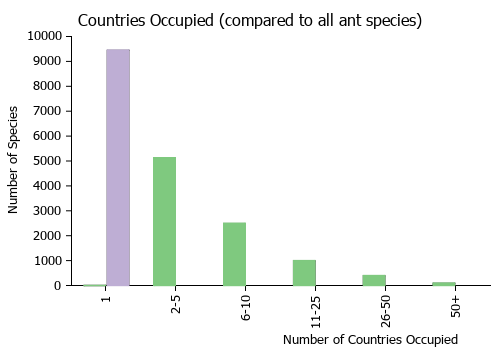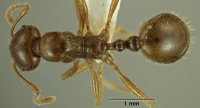Aphaenogaster poultoni
| Aphaenogaster poultoni | |
|---|---|

| |
| Aphaenogaster poultoni | |
| Scientific classification | |
| Kingdom: | Animalia |
| Phylum: | Arthropoda |
| Class: | Insecta |
| Order: | Hymenoptera |
| Family: | Formicidae |
| Subfamily: | Myrmicinae |
| Tribe: | Attini |
| Genus: | Aphaenogaster |
| Species: | A. poultoni |
| Binomial name | |
| Aphaenogaster poultoni Crawley, 1922 | |
This species is restricted to a narrow semi-arid band across south-western Western Australia and is sympatric with A. mediterrae in south-central Western Australia. It is found in coastal scrub, Jarrah forests, dry sandy sclerophyll, mulga woodlands and mallee. Nests are in soil generally with a large crater at the entrance. An exceptionally large mating swarm was noted by McMillan (1977) (misidentified as A. barbigula).
Photo Gallery
 A surprisingly brazen A. poultoni worker inspects the photographer while a fellow nestmate carries sand from their nest. These ants are usually very shy and will readily tumble down their funnel nest entrance at the first sign of danger. Flynn, Western Australia. Photo by Farhan Bokhari, 4 June 2011.
A surprisingly brazen A. poultoni worker inspects the photographer while a fellow nestmate carries sand from their nest. These ants are usually very shy and will readily tumble down their funnel nest entrance at the first sign of danger. Flynn, Western Australia. Photo by Farhan Bokhari, 4 June 2011.
Identification
Majority of hairs on underside of head located laterally and forming a distinct psammophore; eye relatively small (EI less than 21); scape relatively short (SI less than 106); mandibular sculpture composed of irregularly sized striations; petiolar node (in dorsal view) wider than long. This species is most similar to A. barbigula. These two species can be separated by the pattern of sculpturing on the mandibles and the shape of the petiolar node.
There is a tendency for the head of A. poultoni to be more square (when viewed in full face view, the lateral and posterior margins are separated by an angle) compared to both A. barbigula and A. mediterrae (in which the head is essentially uniformly arched behind the eyes in full face view). However, all species show moderate variation in the shape of the head with essentially identical morphologies being found in some individuals of all three species. Thus while this character is indicative of A. poultoni it is not diagnostic.
Keys including this Species
- Key to Aphaenogaster of the southwestern Australian Botanical Province
- Key to Australian Aphaenogaster Species
Distribution
Latitudinal Distribution Pattern
Latitudinal Range: -25.958045° to -33.6166687°.
| North Temperate |
North Subtropical |
Tropical | South Subtropical |
South Temperate |
- Source: AntMaps
Distribution based on Regional Taxon Lists
Australasian Region: Australia (type locality).
Distribution based on AntMaps
Distribution based on AntWeb specimens
Check data from AntWeb
Countries Occupied
| Number of countries occupied by this species based on AntWiki Regional Taxon Lists. In general, fewer countries occupied indicates a narrower range, while more countries indicates a more widespread species. |

|
Estimated Abundance
| Relative abundance based on number of AntMaps records per species (this species within the purple bar). Fewer records (to the left) indicates a less abundant/encountered species while more records (to the right) indicates more abundant/encountered species. |

|
Biology
Castes
Nomenclature
The following information is derived from Barry Bolton's Online Catalogue of the Ants of the World.
- poultoni. Aphaenogaster poultoni Crawley, 1922c: 17, figs. 11, 12 (w.) AUSTRALIA (Western Australia).
- Type-material: syntype workers (number not stated).
- Type-locality: Australia: Western Australia, Beenup, no. 164 (J. Clark).
- [Note: Shattuck, 2008a: 40, says ‘Beenup’ may be Beenyup Brook or Beenyup Swamp.]
- Type-depositories: MVMA, OXUM, WAMP.
- Status as species: Taylor & Brown, 1985: 54; Taylor, 1987a: 8; Bolton, 1995b: 72; Shattuck, 2008a: 40 (redescription); Heterick, 2009: 144.
- Distribution: Australia.
Type Material
- Syntype, 1 worker, unspecified, Australia, Museum Victoria, Melbourne.
- Syntype, worker(s), Beenup, Western Australia, Australia, Oxford University Museum of Natural History.
- Syntype, 10 workers, Beenup, Western Australia, Australia, Western Australian Museum.
- Syntype, 18 workers, Byford, Western Australia, Australia, Queensland Museum.
Description
Posterior margin of head nearly flat in full face view, extending laterally of the occipital collar before passing through a distinct posterolateral corner into the lateral margin of the head. Majority of hairs on venter of head located laterally and forming a distinct psammophore, only scattered hairs on central portion. Mandibular sculpture composed of irregularly sized striations. Erect hairs on mesosomal dorsum tapering to sharp points. Propodeal spines reduced to small denticles or sharp angles. Petiolar node (in dorsal view) wider than long.
References
- Crawley, W. C. (1922). Notes on some Australian ants. Biological notes by E. B. Poulton, D.Sc., M.A., F.R.S., and notes and descriptions of new forms by W. C. Crawley, B.A., F.E.S., F.R.M.S. (concl.). Entomologist's Monthly Magazine, 58: 121–126.
- Crawley, W. C. 1922e. New ants from Australia (concluded from vol. ix. p. 449). Ann. Mag. Nat. Hist. 9(10): 16-36. (page 17, figs. 11, 12 worker described)
- Heterick, B.E. 2021. A guide to the ants of Western Australia. Part I: Systematics. Records of the Western Australian Museum, Supplement 86, 1-245 (doi:10.18195/issn.0313-122x.86.2021.001-245).
- Heterick, B.E. 2022. A guide to the ants of Western Australia. Part II: Distribution and biology. Records of the Western Australian Museum, supplement 86: 247-510 (doi:10.18195/issn.0313-122x.86.2022.247-510).
- McMillan, R. P. (1977). Swarming ants. W.Aust. Nat. 13: 204.
- Shattuck,S.O. (2008). Australian ants of the genus Aphaenogaster (Hymenoptera: Formicidae). Zootaxa, 1677: 25–45.
References based on Global Ant Biodiversity Informatics
- Heterick B. E. 2009. A guide to the ants of south-western Australia. Records of the Western Australian Museum Supplement 76: 1-206.
- Shattuck S. O. 2008. Australian ants of the genus Aphaenogaster (Hymenoptera: Formicidae). Zootaxa 1677: 25-45.





